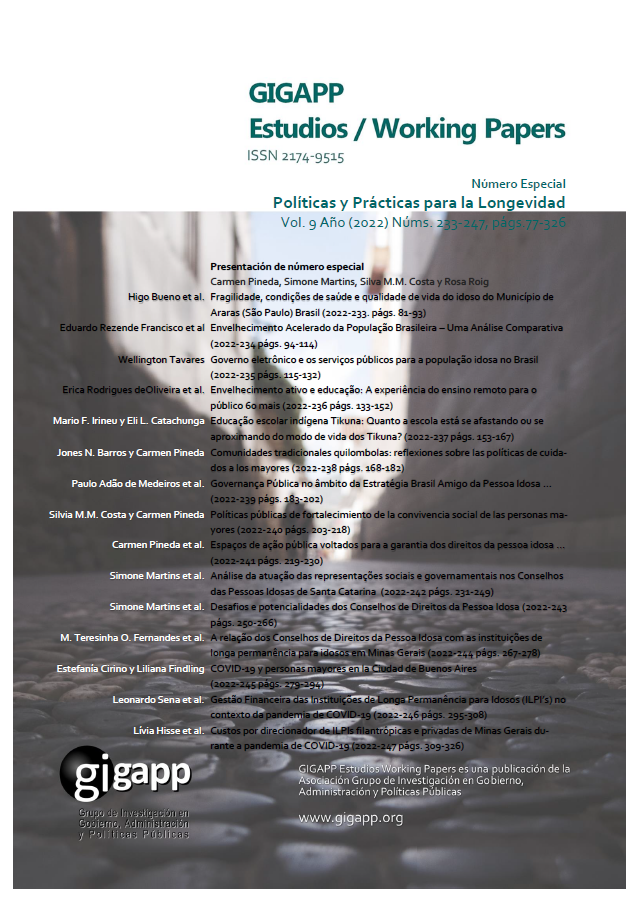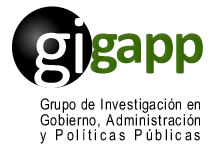Electronic government and public services for the elderly population in Brazil
Abstract
The growth in the use of the internet and its tools has made it possible for the public sector to expand its activities with society through e-gov, or electronic government, which, among a series of possibilities, allows the offer, dissemination and/or realization of public services. Given the growth and representativeness of the elderly population in society, this study aimed to identify, present and discuss public services oriented to elderly people presented in the electronic portals of municipal governments. For this, we sought to identify and list such services in the electronic portals of the municipal governments of the capitals of the twenty-six Brazilian states. It was possible to notice a marked divergence in the quantities and ways in which services are offered and/or informed by the analyzed municipalities, which shows a need to expand the offer of services for the elderly population, as well as to make it easier and more intuitive to find information on government websites.
Downloads
References
Almeida, Ana Paula Santana Coelho et al. 2020. “Falta de acesso e trajetória de utilização de serviços de saúde por idosos brasileiros”, Ciência & Saúde Coletiva, 25(6): 2213-2226.
Akman, Ibrahim et al. 2005. “E-Government: A global view and an empirical evaluation of some attributes of citizens”, Government Information Quarterly, 22(2): 239–257.
Araujo, Marcelo Henrique de et al. 2018. “Serviços de governo eletrônico no Brasil: uma análise a partir das medidas de acesso e competências de uso da internet”. Revista de Administração Pública, Rio de Janeiro, 52(4): 676-694.
Barbosa, Keylla Talitha Fernandes et al. 2017. “Vulnerabilidade da pessoa idosa no acesso aos serviços prestados na Atenção Primária”, Revista Eletrônica de Enfermagem.
Bardin, L. Análise de Conteúdo. Lisboa: Edições 70, 2009. 281p.
BRASIL. 1994. Política Nacional do Idoso. Lei no. 8.842, de 4 de janeiro de 1994. Brasília, 1994. Disponível em: <http://www.planalto.gov.br/ccivil_03/leis/l8842.htm> Acesso em: 10 out. 2022.
Brasil. 2017. “Lei nº 13.460 de 26 de junho de 2017”. Dispõe sobre participação, proteção e defesa dos direitos do usuário dos serviços públicos da administração pública. Diário Oficial da União: seção 1, Brasília, DF, edição 121, p. 4., 27 jun. 2017. Disponível em: <http://www.planalto.gov.br/ccivil_03/_ato2015-2018/2017/lei/l13460.htm> Acesso em: 03 jul. 2022.
Broadbent, Jane y Guthrie, James. 2008. “Public sector to public services: 20 years of “contextual” ac-counting research”, Accounting, Auditing & Accountability Journal, 21(2): 129-169.
Faleiros, Vicente de Paula. 2007. “Cidadania e direitos da pessoa idosa”, Serviço Social, Brasília, 20: 35-61.
Ferreira, Fernanda Pretti Chalet et al. 2014. “Serviços de atenção ao idoso e estratégias de cuidado domi-ciliares e institucionais”, Revista Brasileira de Geriatria e Gerontologia, Rio de Janeiro, 17(4): 911-926.
Luna-Reyes, Luis F. y Gil-Garcia, J. Ramon. 2014. “Digital government transformation and internet portals: the co-evolution of technology, organizations, and institutions”, Government Information Quar-terly, 31(4): 545–555.
May, T. 2004. Pesquisa social: questões, métodos e processos. Trad. Carlos Alberto Silveira Netto Soares. 3. ed. Porto Alegre: Artmed.
Oliveira, M. M. 2010. Como fazer pesquisa qualitativa. 3. ed. revista e ampliada. Petrópolis: Vozes.
Pinho, José Antonio Gomes de. 2008. “Investigando portais de governo eletrônico de estados no Brasil: muita tecnologia, pouca democracia”, Revista de Administração Pública, Rio de Janeiro, 42(3).
Placideli, Nádia et al. 2020. “Avaliação da atenção integral ao idoso em serviços de atenção primária”, Revista Saúde Pública, v. 54, n. 6, 2020.
Relyea, Harold C. 2002. “E-gov: introduction and overview”, Government Information Quarterly, 19(1): 9-35.
Richardson, R. J. et al. 2011. Pesquisa social: métodos e técnicas. 3. ed. revista e ampliada. São Paulo: Atlas.
Sá, Filipe et al. 2016. “Potential dimensions for a local e-Government services quality model”, Telematics and Informatics, 33(1): 270–276.
Santos, Nathália de Melo y Souza, Eda Castro Lucas de. 2021. Evolução e tendência de estudos sobre go-verno eletrônico: mapeamento da área – de 1992 a 2018. Revista De Administração Pública, Rio de Janeiro, v. 55, n. 5, set. - out. 2021, p. 1124-1148.
Silva, Fátima Eugênia de Araújo et al. 2017. “A pessoa idosa e seu acesso aos serviços da política de assis-tência social nos CRAS”, 5º Encontro Internacional de Política Social e 12º Encontro Nacional de Po-lítica Social, Anais..., Vitória.
Vieira, Gilson de Bitencourt et al.. 2015. “O conhecimento da pessoa idosa sobre seus direitos de acesso ao cuidado em saúde”, Ciência, Cuidado e Saúde, 14(4): 1528-1536.
Copyright (c) 2022 Wellington Tavares (Autor/a)

This work is licensed under a Creative Commons Attribution-NonCommercial-ShareAlike 4.0 International License.
Those authors who have publications with this journal, accept the following terms:
a. Authors will retain their copyrights and guarantee the journal the right of first publication of their work, which will be simultaneously subject to the Creative Commons Attribution-NonCommercial-ShareAlike 4.0 International (CC BY-NC-SA Recognition License). 4.0) that allows third parties to share the work as long as its author and its first publication are indicated in this journal.
Under this open access license, readers (users) can:
- Share — copy and redistribute the material in any medium or format
- Adapt — remix, transform, and build upon the material
Under the following terms:
-
Attribution — Users must give appropriate credit, provide a link to the license, and indicate if changes were made. You may do so in any reasonable manner, but not in any way that suggests the licensor endorses you or your use.
-
NonCommercial — Users may not use the material for commercial purposes.
-
ShareAlike — If remix, transform, or build upon the material, users must distribute your contributions under the same license as the original.
- No additional restrictions — Users may not apply legal terms or technological measures that legally restrict others from doing anything the license permits.
b. Authors may adopt other non-exclusive license agreements for the distribution of the version of the published work (eg: deposit it in an institutional telematic archive or publish it in a monographic volume) provided that the initial publication in this journal is indicated.
c. Authors are allowed and recommended to disseminate their work through the Internet (e.g. in institutional telematic files or on their website) before and during the submission process, which can lead to interesting exchanges and increase citations of the published work. (See The effects of open access).



